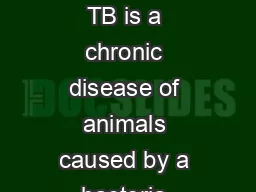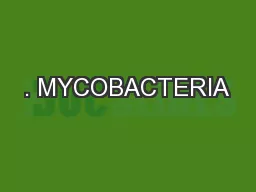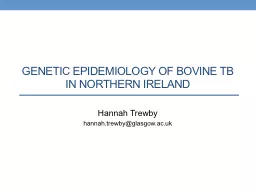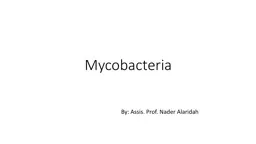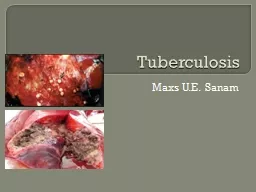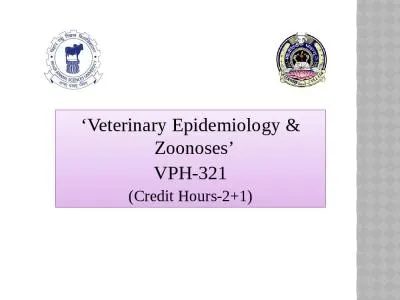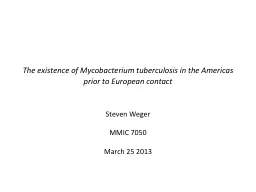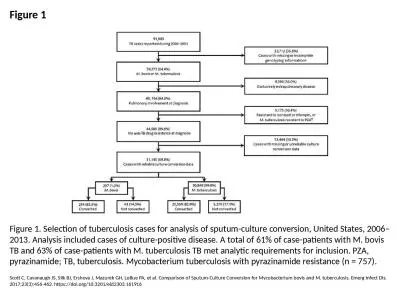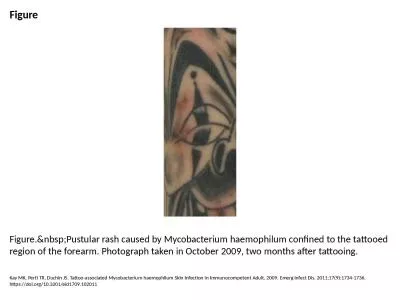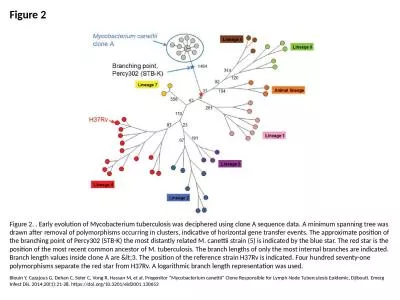PDF-What is Bovine Tuberculosis Bovine tuberculosis TB is a chronic disease of animals caused
Author : pamella-moone | Published Date : 2015-02-26
bovis which is closely related to the bacteria that cause human and avian tuberculosis This disease can affect practically all mammals causing a general state of
Presentation Embed Code
Download Presentation
Download Presentation The PPT/PDF document "What is Bovine Tuberculosis Bovine tuber..." is the property of its rightful owner. Permission is granted to download and print the materials on this website for personal, non-commercial use only, and to display it on your personal computer provided you do not modify the materials and that you retain all copyright notices contained in the materials. By downloading content from our website, you accept the terms of this agreement.
What is Bovine Tuberculosis Bovine tuberculosis TB is a chronic disease of animals caused: Transcript
bovis which is closely related to the bacteria that cause human and avian tuberculosis This disease can affect practically all mammals causing a general state of illness coughing and eventual death The name Tuberculosis comes from the nodules called. tuberculosis Mycobacterium bovis M bovis is another mycobacterium that can cause TB disease in people M bovis is most commonly found in cattle and other animals such as bison elk and deer In people M bovis causes TB disease that can affect the lungs Mycobacterium . bovis. genomics. Stephen Gordon. School of Veterinary Medicine. School of Medicine and Medical Science. School of . Biomolecular. and Biomedical Science. University College Dublin. Ireland…not UK.. . Mycobacteria. cont…... Objectives:. Introduction:. Scientific classification. . Mycobacterium tuberculosis. . Shared . Mycobacterial. . Properties. Transmission . and . Epidemiology. . Pathogenesis. tb. in northern Ireland. Hannah . Trewby. . h. annah.trewby@glasgow.ac.uk. Overview. Relative abundances of different . M. . bovis. . VNTR-types in . NI cattle. Ecological theory combined with simulation modelling to explore possible underlying drivers . Prof.. Nader . Alaridah. Mycobacterium Tuberculosis (. Mtb. ). It was not until the 19th century, when Robert Koch utilized s new staining method (ZN stain) and applied it to sputum from patients discovering the causal agent of the disease Tuberculosis (TB); . bovis. genomics. Stephen Gordon. School of Veterinary Medicine. School of Medicine and Medical Science. School of . Biomolecular. and Biomedical Science. University College Dublin. Ireland…not UK.. . Tuberculosis (TB) adalah penyakit granulamatosa menular, disebabkan oleh kuman genus . Mycobacterium. , berbentuk batang, Gram-positif, dan bersifat tahan asam. Penyakit umumnya berlangsung secara kronis, dan sangat melemahkan (debilitating). Vira Shield In North America, the most common cause of bovine leptospirosis Research shows that hardjo-bovis is the most common host-adapted U.S. serovar and is most frequently associated with reprod Zoonoses. ’. VPH-321. (Credit Hours-2+1). Direct . anthropozoonosis. , . Zooanthroponosis. . . It is a chronic disease of man & animals caused by pathogenic . Mycobacterium spp.. . causing development of tubercle in vital organs. The pulmonary tuberculosis is the most common form, characterized by protective cough, fever, fatigue, weight loss, chest pain and night sweat in human beings. . Steven Weger. . MMIC 7050. . March 25 2013 . Outline. Background Information. Detection in Ancient Samples. Origin of TB. Prehistoric Findings: South America. Prehistoric Findings: North America. Clinical Information l months, although the disease can remain dormant and become active again many years later. The clinical symptoms of bovine TB are simese symptoms who has been in contact with cat Scott C, Cavanaugh JS, Silk BJ, Ershova J, Mazurek GH, LoBue PA, et al. Comparison of Sputum-Culture Conversion for Mycobacterium bovis and M. tuberculosis. Emerg Infect Dis. 2017;23(3):456-462. https://doi.org/10.3201/eid2303.161916. Kay MK, Perti TR, Duchin JS. Tattoo-associated Mycobacterium haemophilum Skin Infection in Immunocompetent Adult, 2009. Emerg Infect Dis. 2011;17(9):1734-1736. https://doi.org/10.3201/eid1709.102011. Blouin Y, Cazajous G, Dehan C, Soler C, Vong R, Hassan M, et al. Progenitor “Mycobacterium canettii” Clone Responsible for Lymph Node Tuberculosis Epidemic, Djibouti. Emerg Infect Dis. 2014;20(1):21-28. https://doi.org/10.3201/eid2001.130652.
Download Document
Here is the link to download the presentation.
"What is Bovine Tuberculosis Bovine tuberculosis TB is a chronic disease of animals caused"The content belongs to its owner. You may download and print it for personal use, without modification, and keep all copyright notices. By downloading, you agree to these terms.
Related Documents

